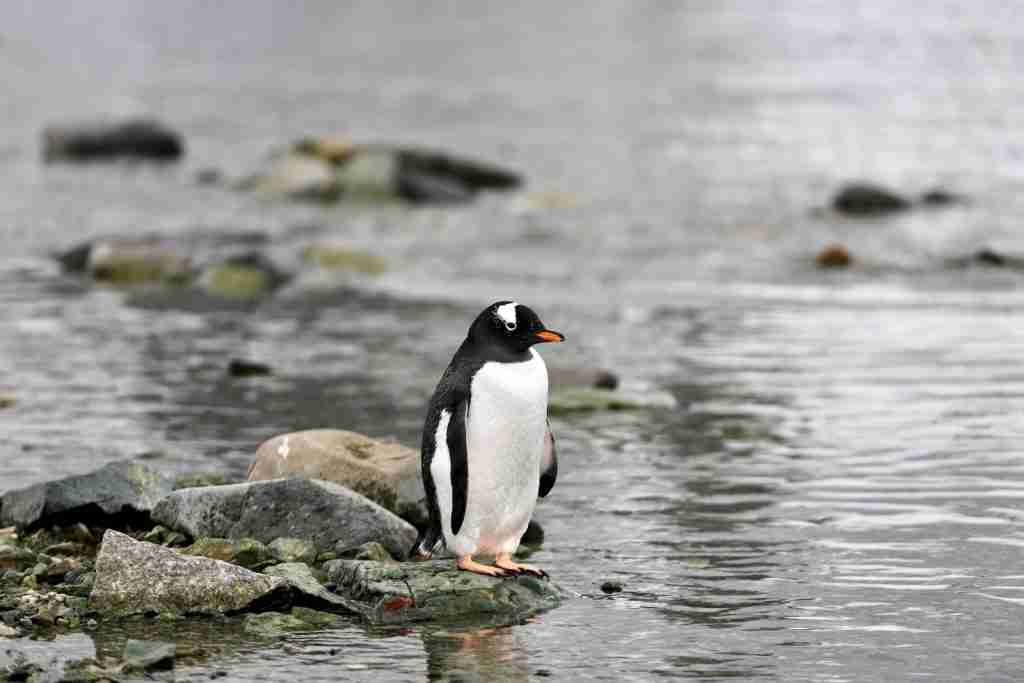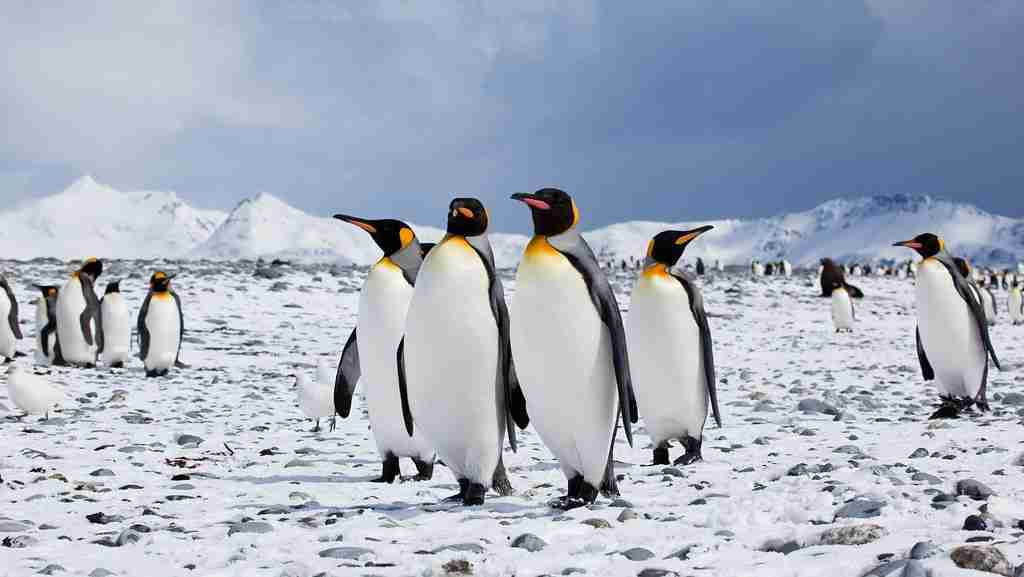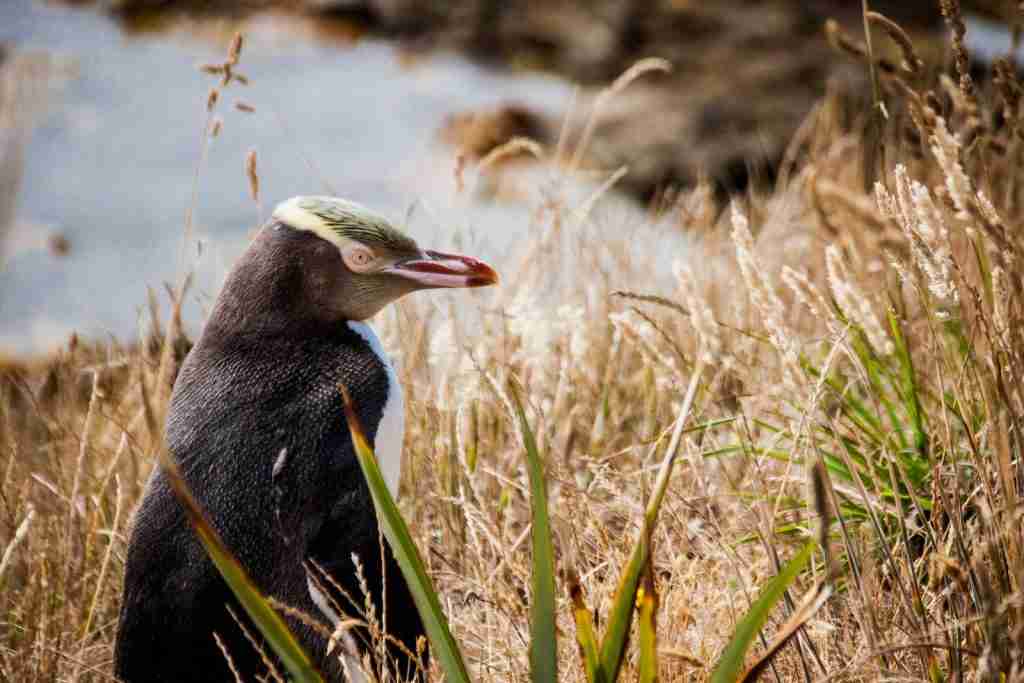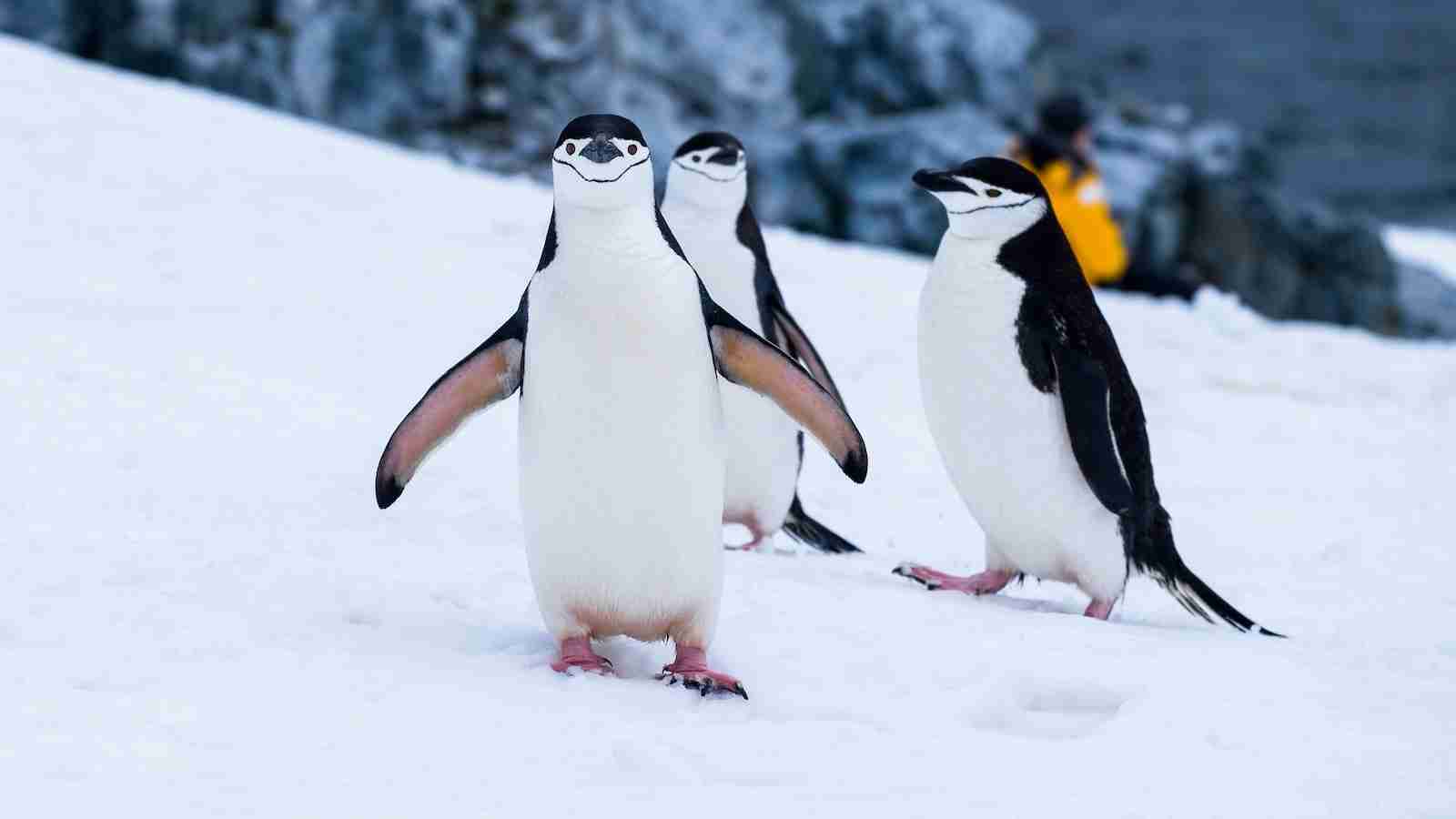24 Fun Facts About Penguins You Never Knew
1. Penguins are flightless birds found only in the Southern Hemisphere.
Penguins, unique and fascinating flightless birds, exclusively inhabit the Southern Hemisphere. With their distinctive black and white plumage, they have adapted to life in the cold regions of Antarctica, South America, Africa, and New Zealand.
Unlike most birds, penguins are exceptional swimmers, using their flipper-like wings to propel themselves gracefully through the water in search of fish and krill, their primary diet.
2. Emperor penguins are the largest and can weigh up to 90 pounds (40 kg).
Among the various penguin species, the Emperor penguin stands out as the largest and most impressive. These majestic creatures can reach staggering weights of up to 90 pounds (40 kg).
Known for their resilience in enduring extreme temperatures, Emperor penguins have evolved remarkable survival strategies, including huddling together in massive colonies to maintain warmth during the harsh Antarctic winters.
3. The smallest penguin species is the Little Blue Penguin.
One of the fun facts about Penguins is that these adorable birds measure approximately 13 inches (33 cm) in height, making them a delightful sight to behold. Often found along the coasts of southern Australia and New Zealand, Little Blue Penguins are skilled divers, diving up to depths of 230 feet (70 meters) in their quest for food.
Despite their diminutive size, they are adept at evading predators and navigating their way through the open ocean.
4. Penguins have excellent swimming skills.

They demonstrate incredible speed in the water, reaching up to 22 mph (35 km/h). Their streamlined bodies and strong flippers allow them to navigate through the ocean with agility and grace.
This skillful swimming is vital for their survival, enabling them to chase after prey and escape from potential predators.
5. Some penguins can dive to depths of over 1,800 feet (550 meters) to find food.
This remarkable feat allows them to explore the ocean’s depths in search of their preferred prey, such as fish, squid, and krill.
Their efficient hunting techniques and adaptability to various aquatic environments contribute to their success as marine predators.
6. Penguins swallow stones, called gastroliths, to help them digest food in their stomachs.
These smooth pebbles play a crucial role in grinding and breaking down the ingested food in their stomachs. By utilizing gastroliths, penguins enhance their digestive processes, extracting the necessary nutrients from their marine diet efficiently.
This unique adaptation demonstrates the remarkable ways in which penguins have adapted to their challenging environment.
7. Unlike most birds, penguins have solid bones, contributing to their diving ability.
Penguins possess a unique characteristic that sets them apart from most birds – solid bones. This uncommon feature significantly contributes to their impressive diving prowess.
By having solid bones, penguins can achieve better buoyancy control and maneuverability underwater, allowing them to navigate through the depths with remarkable ease and grace.
8. Penguins molt once a year, losing their old feathers and growing new ones.
Molting is an essential phase in their lifecycle, enabling them to maintain their feather condition and overall health.
During this period, penguins may appear disheveled as they shed their worn-out plumage which is one of the fun facts about Penguins, but it ultimately ensures their feathers remain in top condition, aiding in their insulation and buoyancy.
9. They have specialized feathers that trap air, providing insulation and buoyancy.

One of the remarkable features of penguins is their specialized feathers, which serve multiple vital functions. These feathers are designed to trap air, creating an insulating layer that helps them brave the frigid waters they inhabit.
The trapped air acts as a barrier against the cold, providing penguins with essential protection against extreme temperatures. Moreover, these feathers contribute to their buoyancy, assisting them in staying afloat while they swim and dive to hunt for food.
10. Penguins often slide on their bellies, a movement called “tobogganing,” to conserve energy while traveling.
This movement involves sliding on their bellies, which allows them to cover distances more efficiently.
By using this technique, penguins can glide over ice and snow, reducing the amount of energy they need to expend during their journeys.
11. Emperor penguins huddle together to stay warm during extreme cold, with temperatures as low as -40°C.
To endure the extreme cold of their habitat, Emperor penguins have developed a unique strategy for staying warm. When faced with temperatures as low as -40°C, these penguins form large huddles.
By gathering closely together, they can collectively generate and retain body heat, providing essential warmth and protection to each member of the group.
12. Penguins use vocalizations, like trumpeting and braying, to communicate with each other.
One of the fun facts about Penguins is that through various sounds, such as trumpeting and braying, they express a wide range of emotions and convey important messages. These activities and changes play a crucial role in their social interactions, enabling them to coordinate activities, locate mates, and warn others about potential dangers.
The ability to communicate effectively is vital for their survival and helps maintain cohesion and harmony within the penguin community.
13. They are monogamous and often mate for life, exhibiting courtship rituals.
Their relationships are characterized by strong commitment and fidelity, and they exhibit elaborate courtship rituals to solidify their bonds.
These courtship displays can involve various behaviors, such as vocalizations, dancing, and preening, which play a crucial role in attracting a suitable partner and strengthening their emotional connection.
14. Male penguins present pebbles to female penguins as a part of their courtship display.
In the world of penguin courtship, male penguins have a charming way of expressing their affection to potential female partners. During courtship, male penguins will present pebbles to the females as a gesture of their dedication and affection.
This offering of pebbles is a significant part of their courtship display and symbolizes their readiness to build a nest together and raise offspring as a united pair.
15. Adelie penguins build nests from stones to protect their eggs from melting snow.
The resourcefulness of Adelie penguins in nurturing their offspring is quite remarkable. To protect their eggs from the harsh Antarctic conditions, Adelie penguins build nests using stones.
These stone nests offer insulation and elevation, keeping the eggs safe from the melting snow and icy ground. This adaptive nesting behavior showcases the penguins’ commitment to ensuring the survival of their young and highlights their ability to adapt to the challenging environment they inhabit.
16. Penguins have a special gland above their eyes to remove excess salt from seawater.
Penguins, fascinating creatures of the Southern Hemisphere, have developed a unique adaptation to cope with their marine environment. This gland allows them to remove excess salt from the seawater they consume, ensuring they stay hydrated and healthy even in their saltwater habitat which is one of the fun facts about Penguins.
This evolutionary feature is vital for their survival, as it helps them thrive in the challenging conditions of the ocean.
17. Penguins are excellent divers, staying underwater for 15-20 minutes on average.
Their underwater skills are truly remarkable, enabling them to explore the depths of the ocean in pursuit of their prey. Penguins can stay submerged for impressive durations, with the average dive lasting between 15 to 20 minutes which is one of the fun facts about Penguins.
This remarkable ability is crucial for their survival as it allows them to hunt efficiently and evade potential predators, making them truly exceptional creatures of the sea.
18. The Galapagos penguin is the only penguin species found north of the equator.
This intriguing fun fact makes it a special species, as it has adapted to live in the tropical and subtropical climates of the Galapagos Islands.
Its presence in these equatorial regions sets it apart from its counterparts, making it an important part of the diverse wildlife found in this iconic archipelago.
20. Emperor penguins can fast for up to four months during the breeding season.
These majestic creatures can endure an astonishing four-month fasting period, relying solely on their energy reserves to survive.
This remarkable adaptation allows them to prioritize the incubation of their eggs and the care of their young, ensuring the next generation’s survival in the harsh Antarctic environment.
21. The Yellow-Eyed Penguin has distinctive yellow eyes and is one of the rarest penguin species.

with its Stunning Yellow Eyes! 🐧💛
The Yellow-Eyed Penguin, a fascinating and captivating species, stands out from its counterparts due to its striking yellow eyes. This penguin is one of the rarest of all, making encounters with these unique creatures a truly extraordinary event.
Native to New Zealand, their dwindling population makes conservation efforts essential to protect them from further decline and potential extinction.
22. Magellanic penguins migrate thousands of miles yearly for food.
Their quest for sustenance leads them to different feeding grounds, ensuring they can provide for themselves and their offspring during various phases of the year.
This remarkable migration strategy showcases the tenacity and adaptability of the Magellanic penguins in the face of changing environmental conditions.
23. Penguins can live up to 20 years or more in the wild, depending on the species.
Throughout their lives, penguins navigate a myriad of challenges, including predation, climate variations, and competition for resources.
Despite these obstacles, their ability to adapt and thrive in their diverse habitats contributes to their extended lifespans. Conservation efforts aimed at preserving their natural environments play a vital role in ensuring the continued survival of these remarkable birds for years to come.
24. Where do the penguins live?
Penguins inhabit a variety of regions in the Southern Hemisphere. They can be found on the coasts of Antarctica as well as on various islands in the Southern Ocean, including South America, Africa, Australia, and New Zealand.
These flightless birds have adapted to a wide range of environments, from icy, polar landscapes to more temperate and sub-Antarctic climates. Some penguin species even venture into tropical areas during certain parts of their life cycle. Overall, penguins have established a remarkable presence across diverse habitats in the Southern Hemisphere.
FAQs
Penguins primarily eat fish, squid, and krill. These marine creatures form the main components of their diet, providing the necessary nutrients to sustain their active lifestyle in the ocean. Penguins are excellent hunters underwater, using their streamlined bodies and powerful flippers to swim swiftly and catch their prey. Depending on their species and location, they may target different types of fish and other small marine organisms found in their habitats. Some penguins, like the Emperor Penguin, can dive to great depths, reaching several hundred meters, in search of food.
Penguins’ habitats are primarily located in the Southern Hemisphere, spanning various regions around Antarctica, the sub-Antarctic islands, parts of South America, Africa, and New Zealand. These flightless birds are well-adapted to thrive in cold and icy environments, and they rely on the ocean for their survival. Many penguin species prefer to inhabit coastal areas, where they can easily access the sea to hunt for food. They build their nests on land, often forming large colonies, which offer protection, warmth, and opportunities for social interactions.
A penguin is a bird. Penguins belong to the avian family Spheniscidae, and they are a group of flightless aquatic birds. While they share some similarities with ducks in their aquatic lifestyle and swimming abilities, they are distinct from ducks taxonomically. Penguins have evolved unique adaptations to thrive in cold, aquatic environments and are well-suited for life at sea. They have streamlined bodies, and flipper-like wings that act as powerful flippers for swimming and are exceptional divers. Penguins also have a specialized layer of feathers that provide insulation and waterproofing, allowing them to stay warm and dry in icy waters.
The term “penguin” originates from the Welsh word “pen gwyn,” which translates to “white head.” The name was originally used to refer to the Great Auk, a now-extinct bird species that had a white patch on its head. When early European explorers encountered the flightless birds that we now know as penguins in the Southern Hemisphere, they saw a resemblance to the Great Auk and started using the same name for these new avian species. Over time, the name “penguin” became commonly associated with these fascinating, tuxedo-clad birds that inhabit the icy regions of the Southern Hemisphere.
There are several different types of penguins, each with its own unique characteristics and habitat preferences. Some of the most well-known penguin species include:
Emperor Penguin (Aptenodytes forsteri): The largest and most iconic of all penguins, found in Antarctica. They are known for their impressive diving abilities and their role in enduring harsh winters to protect their eggs.
King Penguin (Aptenodytes patagonicus): The second-largest penguin species, also found in the sub-Antarctic regions. They have a striking orange patch on their chest.
Adélie Penguin (Pygoscelis adeliae): Known for their distinct white ring around the eyes, they are commonly found along the Antarctic coastlines and surrounding islands.
Gentoo Penguin (Pygoscelis papua): Recognized by their bright orange-red bills and white stripe on the top of their heads. They inhabit the Antarctic Peninsula and nearby islands.
Chinstrap Penguin (Pygoscelis antarcticus): Named for the thin black band under their chin, they are frequently seen on various Antarctic and sub-Antarctic islands.
Rockhopper Penguin (Eudyptes chrysocome): These small penguins have distinctive crests of spiky yellow feathers above their eyes. They are found on sub-Antarctic islands.
Macaroni Penguin (Eudyptes chrysolophus): Easily identifiable by their yellow crests, they breed in large colonies on sub-Antarctic islands.
African Penguin (Spheniscus demersus): The only species that breeds in Africa, specifically along the south-western coast. They are also known as the “Jackass Penguin” due to their braying call.
Galapagos Penguin (Spheniscus mendiculus): The only penguin species found north of the equator, residing on the Galapagos Islands.
Humboldt Penguin (Spheniscus humboldti): Native to the coasts of South America, particularly Chile and Peru.







